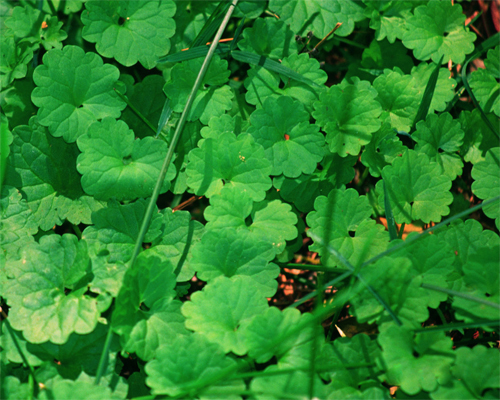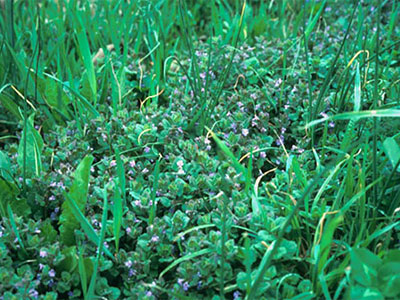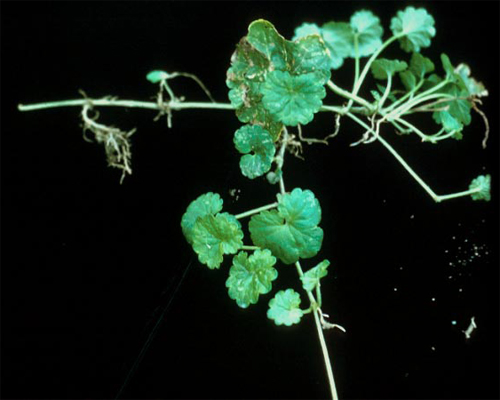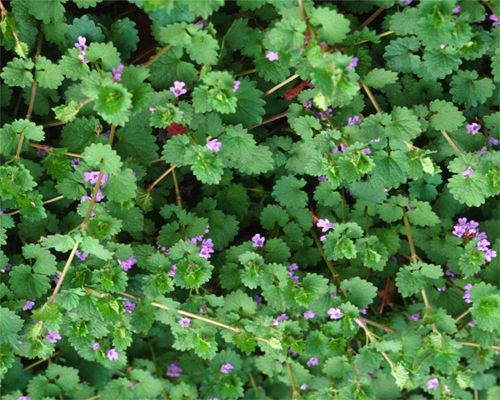
Fact Sheet FS1219
Ground Ivy (Glechoma hederacea), also known as 'Creeping Charlie', 'Creeping Jenny' and 'Gill-Overthe-Ground', is a common perennial, evergreen weed found throughout New Jersey. It thrives in shady, moist areas in low wooded habitats, along roadsides, and in disturbed sites. From such places it can easily invade home lawns and can quickly crowd out the more desirable turfgrass. True to its name, it creeps along the soil surface and forms roots where the leaves join the stem.
Botanical Characteristics
Ground Ivy is an evergreen, aromatic plant in the mint family. It can reach a height of between 12 and 20 inches. Leaves are 0.8 to 1.2 inches across, opposite and heart-shaped, with scalloped edges. Stems can range in length from 15–30 inches long. Clusters of two or more lavender-colored flowers, 0.4 inch long, bloom on vertical stems from March through July.
Cultural Control
This persistent weed grows most successfully in shady areas or sparse lawns. Good horticultural practices that encourage a thick and healthy lawn are the first line of defense against ground ivy. Increasing sunlight to the lawn by trimming trees, fertilizing and watering turfgrass properly and cutting the lawn to the correct height will promote vigorous growth of turf. For specific lawn care advice, see Rutgers Cooperative Extension (RCE) fact sheet FS102, "Your Lawn and Its Care".
Chemical Control
Ground ivy is best controlled chemically by applying the herbicide Triclopyr. Triclopyr and 2,4-D combinations may also provide control however the best control occurs when using Triclopyr alone. Herbicide formulations that contain 2,4-D alone will not be effective for control. Herbicides which contain the active ingredient MCPP and/or Dicamba will only suppress the weed. For the effectiveness of other herbicide combinations, please refer to RCE fact sheet FS385, "Broadleaf Weed Control in Cool Season Turfgrasses".
Treatment is most effective in the autumn months when daytime temperatures have dropped to the 60s or low 70s. Choose a day when no rain is forecast for 48 hours following your chemical application. Read the product label carefully to determine application rates and the reapplication schedule if needed.
Ground ivy frequently grows in the shade of trees or shrubs. In these areas, spray only to wet the leaves of the ground ivy and make sure not to soak the ground to avoid uptake of the herbicide by the roots of the woody plants. Any woody or broad-leaf plant that comes into contact with an herbicide may be damaged or killed. Always be cautious when handling and using any herbicide; do not spray during hot or windy weather to avoid any herbicide drifting onto desirable plants. And before using any chemical, especially herbicides, please read the label completely and follow all the manufacturer's directions carefully.

Ground Ivy. Photo credit: Dr. John Meade, weed specialist emeritus.
Mechanical Control
If you have a small area of ground ivy and wish to use a mechanical means to eradicate the plant, you may use a sod lifter (a hand tool) or a sod cutter (a power tool) followed by reseeding or the installation of sod. If the area is shady and moist, consider replacing the grass with shade-tolerant ground cover plants or even decorative mulch.
Selected References
Photos courtesy of Dr. John Meade, weed specialist emeritus (center photo in header and large photo); John D. Byrd, Mississippi State University (left photo in header); and Charles T. Bryson, USDA Agricultural Research Service (right photo in header).
November 2013
Copyright © 2024 Rutgers, The State University of New Jersey. All rights reserved.
For more information: njaes.rutgers.edu.
Cooperating Agencies: Rutgers, The State University of New Jersey, U.S. Department of Agriculture, and Boards of County Commissioners. Rutgers Cooperative Extension, a unit of the Rutgers New Jersey Agricultural Experiment Station, is an equal opportunity program provider and employer.



